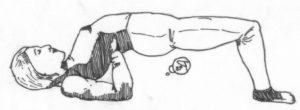A Series of 20 Tantric Kriyas: #1 Viparita Karani Mudra
As many of us move indoors with the cooler weather I thought it would be a good time to share a series of 20 Tantric Kriyas for investigating our inner essence. These 20 kriyas were taught to me by my teacher Hari, and are described in my book Letters from the Yoga Masters. Reading them is one thing; experiencing them takes me deep within on a journey of self-discovery.
Hari taught me the following twenty kriya yoga practices related to the stages of pratyahara (withdrawal from the senses), dharana (concentration), and dhyana (meditation). The techniques build on each other, so they are intended to eventually be done as one complete practice, one after the other. For example, learn the first kriya and practice it daily for a week. Then learn the second kriya and do the first and second together for a week. Then learn the third kriya, and practice all three for a week. Once all the kriyas are learned, the entire practice can be done as one. We will introduce you to one practice each month.
This process would take a long time to do, so I suggest you start to work with these kriyas one at a time, and then perhaps thread a few together for a longer practice. Some of them bundle together quite beautifully.
The first nine kriyas are pratyahara kriyas. These are followed by ten dharana kriyas. The final practice is one dhyana kriya. These make up an incredibly abundant and powerful practice outlined in Letters from the Yoga Masters from pages 147-160.
Viparita Karani Mudra #1
This mudra is done in a half-shoulderstand position, reversing the body. This allows the

amrita nectar from the Soma Chakra above the palate to flow in the opposite direction of gravity
. While holding the mudra there is a specific rotation of consciousness for your mind to follow, creating a loop of energy.
If half-shoulderstand position is not available to you, the rotation of consciousness can also be done in setu bandhasana, the bridge pose. 
Additional “ingredients” are amritpan khechari mudra, and Ujjayi breathing (described further below). You can add these into the practice at whatever point you feel ready to do so, but first just familiarize yourself with the rotation of consciousness.
At the bottom of this article, be sure to check out the YouTube video with guidance.
Method:
Go into viparitakarani mudra (the half-shoulderstand pose) so the body is inverted (or bridge pose for more comfort). Close the eyes.
Hold the breath briefly and imagine the nectar cooling here, then exhale this cooled stream of nectar to the ajna chakra (space between the eyebrows), then to the bindu (the posterior fontanel at the back of the head) and to the sahasrara chakra at the crown of the head.
From sahasrara, move right back down to the manipura chakra for the next inhalation to repeat the process, increasing the flow of nectar. Repeat this process, gradually working up to eleven repetitions. Advanced practice is to repeat this process twenty-one times.
Adding in Amritpan Khechari and Ujjayi to the process:
Amritam is “nectar of immortality.” The name of this technique means “to drink the nectar of immortality.” According to Madhavananda who taught Hari, this takes you into deeper and profoundly subtler regions, beyond the intellectual and analytical layer. Keep the mouth closed and gently curl back the tip of the tongue toward the soft palate, to the best of your ability. Breathe with the tongue curled back, creating a natural Ujjayi breathing so you can hear the soft sound of your breath.
Indu Arora sheds more light on the body position of this mudra, including the energetic and subtle physiology.
Viparita Karani mudra image is drawing by Mugs McConnell in Letters from the Yoga Masters.
Setu Bandhasana image is drawn by Thor Polukoshko for SOYA.

Recent Comments